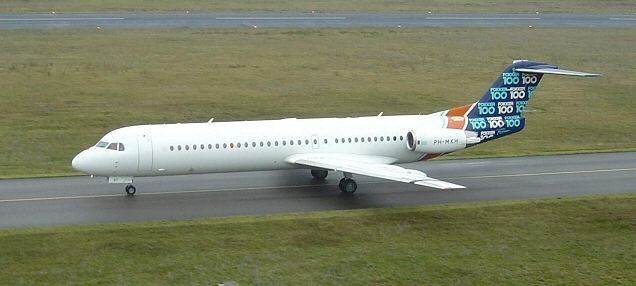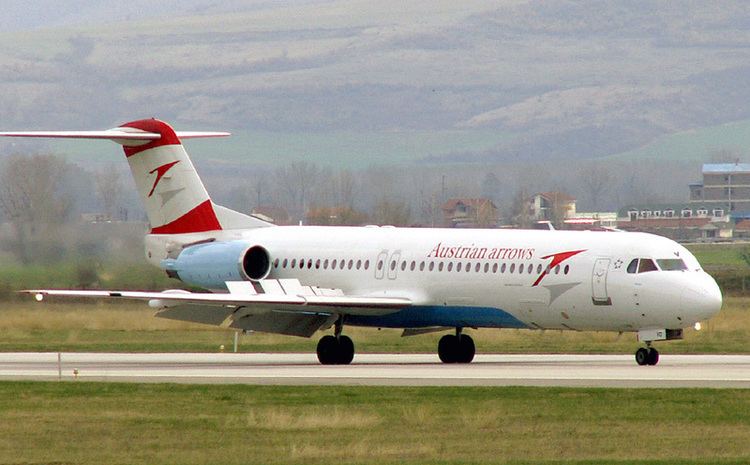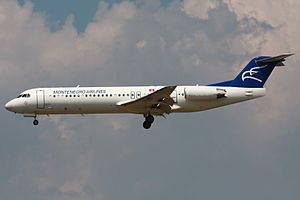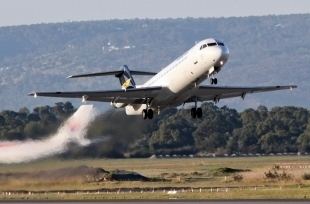Wingspan 28 m Cruise speed 800 km/h Introduced February 1988 | Top speed 856 km/h Length 36 m Engine type Rolls-Royce RB.183 Tay | |
 | ||
Fantastic fokker 100 siholuette landing in frankfurt montenegro airlines airclips
The Fokker 100 is a medium-sized, twin-turbofan airliner from Fokker. Upon introduction, the type possessed low operational costs and had scant competition in the 100-seat short-range class of regional airliner, which contributed to strong sales during the late 1980s. It was the largest jet airliner built by Fokker before its bankruptcy in 1996.
Contents
- Fantastic fokker 100 siholuette landing in frankfurt montenegro airlines airclips
- Origins
- Potential revival
- Operational history
- Airlines
- Governments
- Former operators
- Accidents and incidents
- Aircraft on display
- Specifications
- References

However, the Fokker 100 was soon faced with an increasing number of passenger aircraft similar in both size and role were brought onto the market by competing firms during the 1990s, leading to a substantial decline in both sales and long term prospects. Fokker had also encountered financial difficulties, having been bought up by Deutsche Aerospace AG, who in turn had financial troubles of their own, restricting their ability to support multiple regional airliner programmes. Accordingly, in 1997, production of the Fokker 100 was terminated after 283 airframes had been delivered.

By July 2016, a total of 116 Fokker 100 aircraft remained in airline service with 26 airlines around the world. Despite the fact that airlines are currently retiring the aircraft, there are still large numbers in operation in both Australia and Iran.

Origins
In 1983, what was initially known as the Fokker F28 Mk 0100 program was announced as an updated replacement for Fokker's popular, but superseded, F28 Fellowship jet airliner. Subsequently, marketed as the Fokker 100, the design was based on the original F28, but featured modern avionics, a pair of new-generation Rolls-Royce Tay turbofan engines, and a redesigned wing. However, the most noticeable difference was the longer fuselage, which had increased seating by 65 per cent from 65 of the original F28 series to a maximum of 107 in a three-by-two single-class arrangement. The new wing was claimed by Fokker to be 30 per cent more efficient in cruise, while still retaining the simplicity of a fixed leading edge. The cockpit was updated with a Rockwell Collins DU-1000 electronic flight instrument system. Like the Fokker Fellowship, the Fokker 100 retained the twin rear fuselage-mounted engines and T-tail configuration, a similar arrangement to that of the Douglas DC-9 family. The Fokker 100 does not have eyebrow windows above the main cockpit windows as on the Fokker F28.
A pair of prototypes were built. On 30 November 1986, the first prototype, PH-MKH, flew for the first time, while the second, PH-MKC, followed on 25 February 1987. In November 1987, the new airliner's type certificate was awarded, clearing the Fokker 100 to enter operational service. In February 1988, the first deliveries of the Tay 620-15 powered versions started to Swissair. American Airlines (75 aircraft ordered), TAM Transportes Aéreos Regionais (now LATAM Airlines) (50 aircraft) and USAir (40 aircraft) were major customers of the Fokker 100 and their aircraft were powered by the more powerful Tay 650-15.
During the early 1990s, Fokker and Deutsche Aerospace AG had explored the prospects of a commercial relationship to mutually engage the regional aircraft market; these discussions cumulated in Deutsche Aerospace purchasing a 40 per cent stake in Fokker in 1993. However, by 1995, both Fokker and Deutsche Aerospace were suffering from substantial financial difficulties, which ultimately led to the abortion of the latter's ambitions to dominate the European regional aircraft market. In June 1996, Deutsche Aerospace sold the majority of Dornier Luftfahrt GmbH to American manufacturer Fairchild Aircraft, leading to the creation of Fairchild Dornier GmbH. The newly combined Fairchild Dornier company emerged as the third largest regional aircraft manufacturer in the world.
Although the Fokker 100 itself proved to be popular and an effective success in the marketplace, Fokker had remained a loss-making business for several years. In 1996, the accumulated losses contributed to the collapse of Fokker. During early 1997, production of the Fokker 100 was wound up.
Potential revival
Discussions regarding the potential for either portions or the entirety of Fokker being purchased by Bombardier are known to have taken place, but talks ultimately fell through without a deal being reached. Dutch firm Stork B.V. has since acquired the maintenance business for the type and has since been providing services to existing operators, having adopted the name Fokker Aviation. Like any number of regional airliner designs, the Fokker 70/100 was being increasingly squeezed from below by stretched versions of the Bombardier and Embraer regional jets; this intense competitive pressure had also been responsible for killing off plans for the Fairchild Dornier 528JET/728JET/928JET along with an unnamed design being considered by ATR. At one point, there was a proposal for a stretched version of the Fokker 100, known as the Fokker 130, however this was never built.
In 1999, it was announced that an Amsterdam-based group, Rekkof Restart (Rekkof is Fokker spelled backwards), had entered into negotiations with the intention of reopening both the Fokker 70 and 100 lines. During the 2000s, the Netherlands Aircraft Company (otherwise known as NG Aircraft) was formed for the purpose of restarting production. However, the ambition has suffered some delays, including some false starts. In March 2010, NG Aircraft stated that it had securing funding from the Ministry of Economic Affairs to adapt an existing Fokker 100 to serve as a prototype for an planned improved new-build series; that same month the company announced its interest in converting existing aircraft to a proposed new-build equvilent standard, in addition to its primary focus of constructing wholly new Fokker 100s. In March 2011, it was announced that the government of Brazil had formed a partnership for the revival of the Fokker 100.
In July 2014, Maarten Van Eeghen, chief executive of NG Aircraft, revealed more details about the pending revival and the new generation of aircraft that would be produced. Dubbed the F120NG, it would be a new-build aircraft, seating a maximum of 125 to 130 passengers, that would be essentially a stretched model of the base Fokker 100. It would adopt a new powerplant, the Pratt & Whitney PurePower PW1X17G turbofan engine rated at 17,600lb thrust, which is claimed to result in the new generation airliner burning 50 per cent less fuel per seat than the original Fokker 100. It was claimed in 2014 that the earliest entry-to-service date for the F120NG would be 2019, based on a five-year development and testing programme after obtaining official clearance to proceed.
Operational history
By 1991, Fokker had produced 70 units and had orders for more than 230. In 1993, an extended-range version of the Fokker 100, outfitted with additional fuel tanks in the centre fuselage, was introduced; it was followed by a quick-change passenger/freighter version in 1994, designated as the Fokker 100QC. In 1993, a shortened version of the airliner was introduced, designated as the Fokker 70; this aircraft was intended as a replacement for the earlier Fokker F28 and featured the removal of 4.70 m (15.42 ft) of the fuselage and reduced seating of 80. Third party aircraft companies, such as Phoenix Aero Solutions, have since offered their own conversion programs to produce freights from former airliner configuration Fokker 100s. While studies were conducted on a proposed 130-seat Fokker 130, this proposal ultimately did not reach further stages of development.
In 2003, a Fokker 100EJ (Executive Jet) variant was introduced, these were remanufactured aircraft produced by Fokker Services as conversions from used Fokker 100 airliners. Priced at around $12 million, the Fokker 100EJ seated between 19 and 31 passengers in three different luxury configurations, all which featured galleys, while two were outfitted with shower-equipped master suites; additional features include an auxiliary fuel system to extend the aircraft's range by roughly 1,600km. By late 2009, a total of six Fokker 100s were in VIP service, while a further two were used in a 50-seat corporate layout.
Following the end of production in 1997, existing Fokker 100 airliners continued to be supported and used by operators. As a consequence of the Great Recession of the late 2000s, a large number of the type were retired from airline service, some later returned to operations while a considerable portion were broken up instead. In March 2009, Mexicana announced that the confirmation of an agreement with Boeing to lease 25 Boeing 717s as a replacement for its fleet of 25 Fokker 100s. In September 2009, one of the last Asian operators of the type, Mandarin Airlines, phased out the last of its Fokker 100. According to maintenance and servicing company Fokker Services, Fokker 100 airliners constructed during the 1990s had been anticipated to be serviceable until 2035, while the type was expected to remain competitive without modification until at least 2020.
In August 2009, Australian airline Skywest Airlines announced that it would be outfitted its fleet of Fokker 100 and Fokker 70 aircraft with a new global navigation satellite system navigational suites; these had the advantage of enabling shorter approaches at night and in bad weather, saves time and fuel, and increases safety and schedule reliability, as well as increasing the number of usable airports by the type.
From 2015, the French DGA Essais en Vol had used the Fokker 100 as a flying testbed; it is referred to as the ABE-NG, standing for Avion Banc-d'Essais de Nouvelle Génération. It has replaced the DGA's previous testbed of choice, the Dassault Falcon 20 business jet, and has been outfitted with various systems of the Dassault Rafale fighter aircraft for testing purposes, including the Rafale's nose section, Thales RBE2 active electronically scanned array (AESA) radar and optronics equipment, as well as a Reco NG targeting pod under the fuselage and a compliment of MBDA Mica air-to-air missiles. The first aircraft, which was formerly used by Régional, is to be followed by four more used Fokker 100s.
In June 2015, Austrian Airlines, then one of the larger operators of the Fokker 100, announced its approval of a plan to procure used Embraer 195 regional jets to replace its inventory of Fokker 100 and Fokker 70 jets, which had an average age of 21 years across the fleet. In November 2015, Alliance Airlines has announced that it shall acquire the entire Austrian Airlines fleet of 21 Fokker 100 and Fokker 70 airliners.
Airlines
As of 23 October 2016, 165 aircraft are still in operational use with airlines. Many of them are used in Australia by Alliance Airlines, Virgin Australia Regional Airlines and QantasLink in support of the mining industry, with low utilisation rates for an airline, around 1,200 hours per year.
